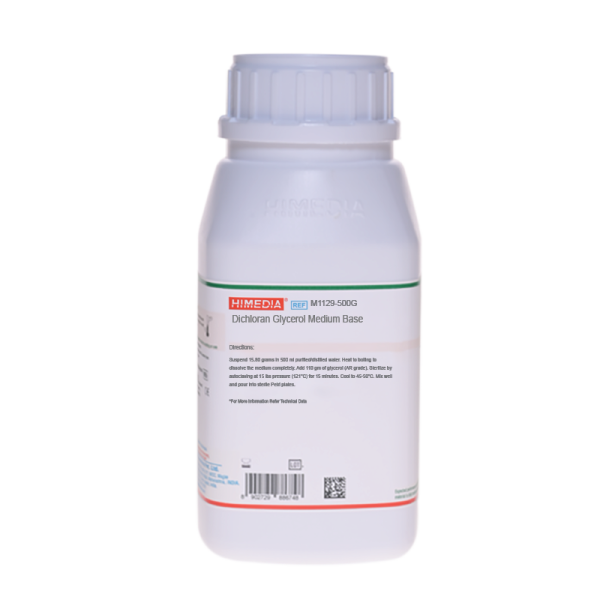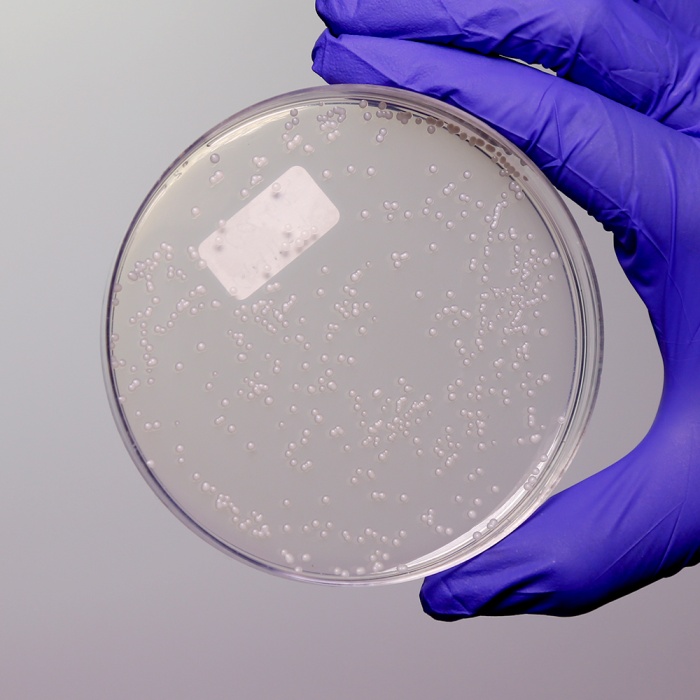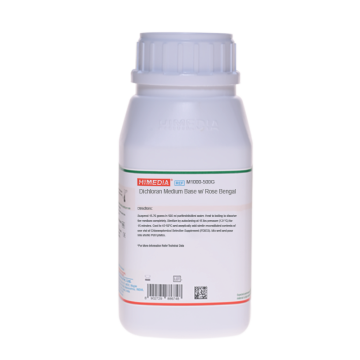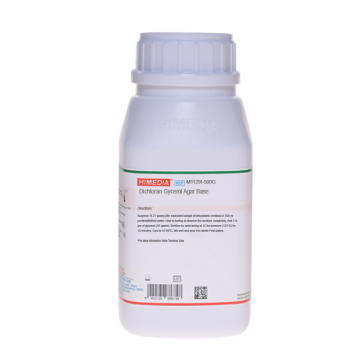 Your enquiry has been submitted
Your enquiry has been submitted
Dichloran Glycerol Medium Base
Total Yeast and Mold Count#CC293D
Intended use
Recommended for selective isolation of xerophilic moulds from food and clinical samples.
Composition**
| Ingredients | g/L |
|---|---|
| Peptone | 5.000 |
| Dextrose (Glucose) | 10.000 |
| Potassium dihydrogen phosphate | 1.000 |
| Magnesium sulphate | 0.500 |
| Dichloran | 0.002 |
| Chloramphenicol | 0.100 |
| Agar | 15.000 |
Final pH (at 25°C): 5.6±0.2
**Formula adjusted, standardized to suit performance parameters
Directions
Suspend 15.8 grams in 500 ml purified / distilled water. Heat to boiling to dissolve the medium completely. Add 110 grams of glycerol (Analytical Reagent Grade). Sterilize by autoclaving at 15 lbs pressure (121°C) for 15 minutes. Cool to 45-50°C. Mix well and pour into sterile Petri plates.
Principle And Interpretation
Dichloran Glycerol Medium was formulated by Hocking and Pitt (1) and is recommended for isolation and enumeration of xerophilic moulds from dried and semidried foods. The glycerol at 18% (w/w) lowers the water activity (aw) from 0.999 to 0.95 (2) without causing any problem. This restrictive characteristic makes the medium especially suitable for foods. Peptone provides carbon, nitrogen, vitamins and minerals. Dextrose (Glucose) is a carbohydrate source. Phosphate buffers the medium. Magnesium sulfate provides divalent cations and sulfate. Dichloran is an antifungal agent, added to the medium to reduce colony diameters of spreading fungi. This medium can also be used for isolation of fungi from clinical samples. Chloramphenicol is included to inhibit the growth of bacteria present in environmental and food samples. Inhibition of growth of bacteria and restriction of spreading of more-rapidly growing moulds aids in the isolation of slow-growing fungi by preventing their overgrowth by more-rapidly growing species.
Process 40 gm of food sample in a stomacher by adding 200 ml of 0.1% Peptone Water (M028). Shake periodically for 30 minutes with 0.1% Peptone Water for powdered products. Dilute the sample to 1:10 in 0.1% Peptone water and spread on plate. Count the number of Xerophilic colonies per gram of food. The medium can also be used as general medium for the isolation of yeasts and moulds from foodstuffs (2).
Type of specimen
Clinical samples - skin scrapings/ skin lesions, etc.; Food samples
Specimen Collection and Handling:
For clinical samples follow appropriate techniques for handling specimens as per established guidelines (3,4).
For food samples, follow appropriate techniques for sample collection and processing as per guidelines (5).
After use, contaminated materials must be sterilized by autoclaving before discarding.
Warning and Precaution
In Vitro diagnostic Use. For professional use only. Read the label before opening the container. Wear protective gloves/ protective clothing/eye protection/face protection. Follow good microbiological lab practices while handling specimens and culture. Standard precautions as per established guidelines should be followed while handling clinical specimens. Safety guidelines may be referred in individual safety data sheets.
Limitations :
- Individual organisms differ in their growth requirement and may show variable growth patterns on the medium.
- Each lot of the medium has been tested for the organisms specified on the COA. It is recommended to users to validate the medium for any specific microorganism other than mentioned in the COA based on the user's unique requirement.
- Further serological and biochemical testing is required for complete identification.
Performance and Evaluation
Performance of the medium is expected when used as per the direction on the label within the expiry period when stored at recommended temperature.
Quality Control
Appearance: Cream to yellow homogeneous free flowing powder
Gelling: Firm,comparable with 1.5% Agar gel
Colour and Clarity of prepared medium: Medium amber coloured, clear to slightly opalescent gel forms in Petri plates
Reaction: Reaction of 3.16% w/v aqueous solution 22 grams of glycerol at 25°C. pH : 5.6±0.2
pH: 5.40-5.80
Cultural Response: Cultural characteristics observed with added 22 grams of glycerol after an incubation at 25°C for upto 6 days.
| Organism | Inoculum (CFU) | Growth | Recovery |
|---|---|---|---|
| **Bacillus spizizennii ATCC 6633 (00003*) | >=104 | inhibited | 0% |
| Candida albicans ATCC 10231 (00054*) | 50-100 | good-luxuriant | >=50% |
| Escherichia coli ATCC 25922 (00013*) | >=104 | inhibited | 0% |
| Mucor racemosus ATCC 42647 | 50-100 | good-luxuriant | |
| Saccharomyces cerevisiae ATCC 9763 (00058*) | 50-100 | good-luxuriant | >=50% |
Key: (*) Corresponding WDCM numbers. Formerly known as Bacillus subtilis subsp. spizizenii
Storage and Shelf Life
Store between 15-25°C in a tightly closed container and the prepared medium at 20-30°C. Use before expiry date on the label. On opening, product should be properly stored dry, after tightly capping the bottle inorder to prevent lump formation due to the hygroscopic nature of the product. Improper storage of the product may lead to lump formation. Store in dry ventilated area protected from extremes of temperature and sources of ignition Seal the container tightly after use. Product performance is best if used within stated expiry period.
Disposal
User must ensure safe disposal by autoclaving and/or incineration of used or unusable preparations of this product. Follow established laboratory procedures in disposing of infectious materials and material that comes into contact with clinical sample must be decontaminated and disposed of in accordance with current laboratory techniques (3,4).
Reference
- Hocking A.D. and Pitt J.I., 1980, J. Appl. Environ. Microbiol., 39:488.
- Beckers H.J., et al, 1982, Intern. Stand. Org. Document ISO/TC34/SC9/N151.
- Isenberg, H.D. Clinical Microbiology Procedures Handbook 2nd Edition.
- Jorgensen, J.H., Pfaller, M.A., Carroll, K.C., Funke, G., Landry, M.L., Richter, S.S and Warnock., D.W. (2015) Manual of Clinical Microbiology, 11th Edition. Vol. 1.
- Salfinger Y., and Tortorello M.L., 2015, Compendium of Methods for the Microbiological Examination of Foods, 5th Ed., American Public Health Association, Washington, D.C.
| Product Name | Dichloran Glycerol Medium Base |
|---|---|
| SKU | M1129 |
| Product Type | Regular |
| Physical Form | Powder |
| Origin | Animal |
| Packaging type | HDPE |
| References | 1. Hocking A.D. and Pitt J.I., 1980, J. Appl. Environ. Microbiol., 39:488. |
| Customized Product Available | No |









